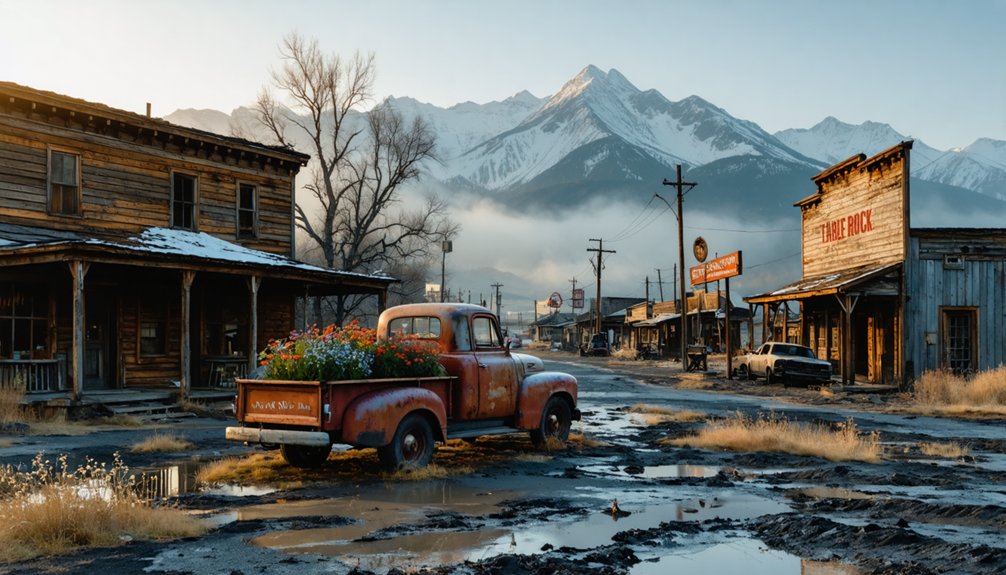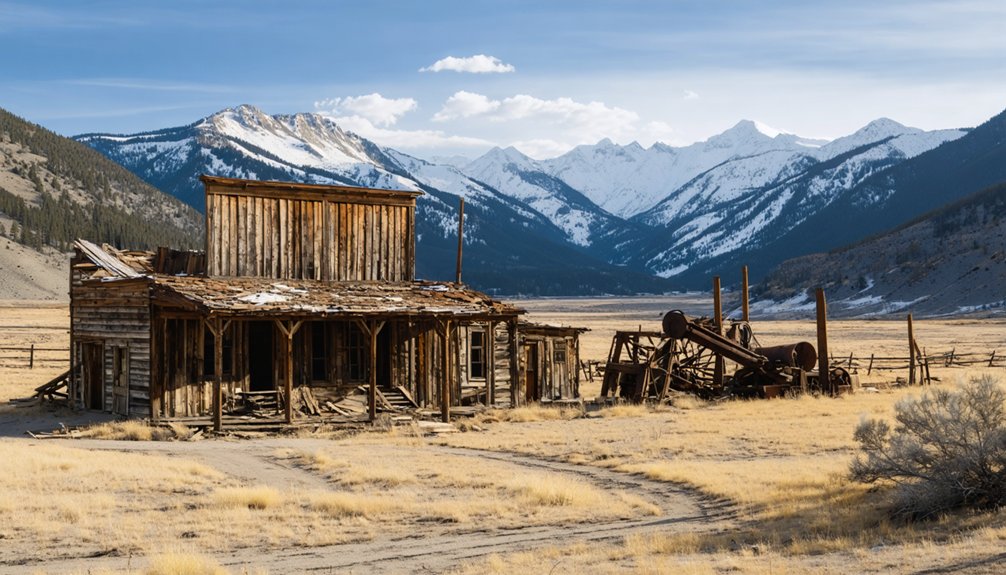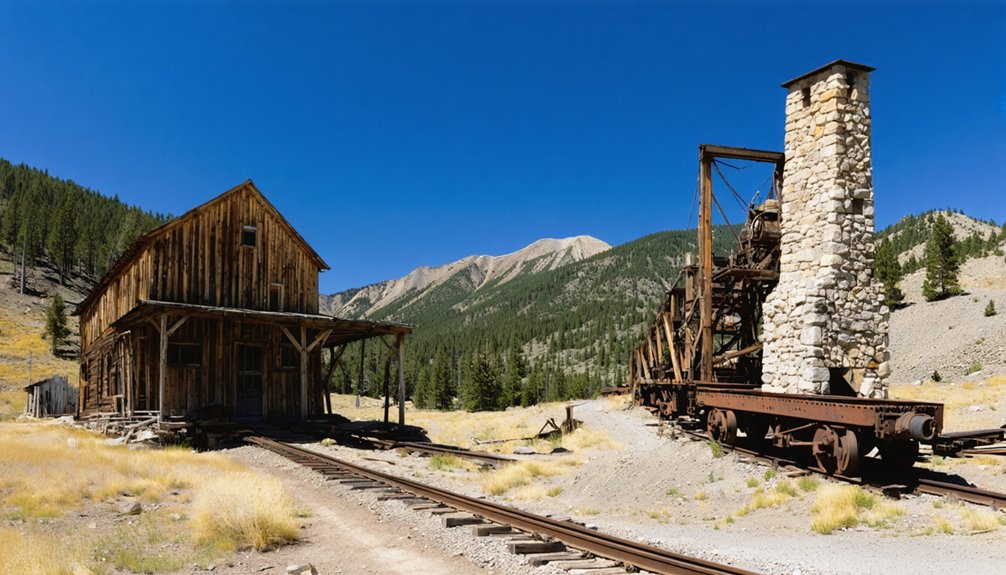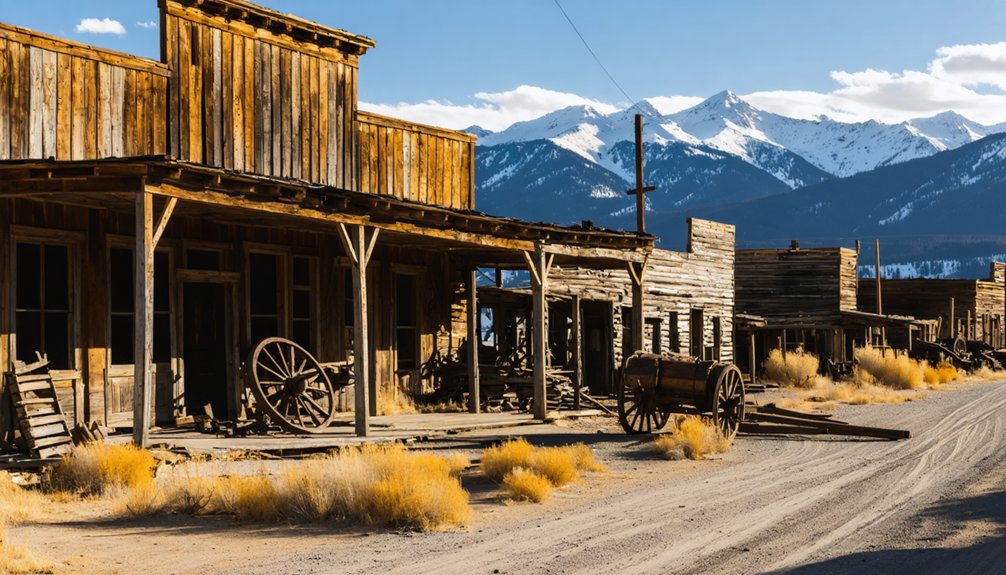Table Rock, a forgotten Colorado mining settlement from the 1800s, offers you a glimpse into frontier life through its deteriorating foundations and rusted machinery. You’ll find the remnants of the Kalamazoo Hotel and ore-crushing equipment that tell the story of its brief prosperity. The ghost town is particularly active with paranormal phenomena on April 21st, marking a deadly 1887 mining disaster. The Midnight Tales Tour reveals why some souls never left these haunted ruins.
Key Takeaways
- Table Rock was established during Colorado’s mining rush in the late 1800s, following patterns of brief prosperity before decline.
- Physical remnants today include forgotten foundations, mining machinery, and partially preserved structures showing the original town layout.
- The ghost town experiences reported paranormal activity, especially in April, linked to a catastrophic mining disaster on April 21, 1887.
- Visitors can experience guided tours like the Midnight Tales Tour featuring alleged ghostly encounters at abandoned buildings and the cemetery.
- The site is accessible via multiple trailheads in North Park region, offering self-guided tours ranging from one to three hours.
The Mining Boom That Built Table Rock
While a veil of historical obscurity surrounds much of Table Rock‘s early beginnings, archaeological and historical records indicate that the mining boom that established this now-abandoned settlement likely began in the late 1800s during Colorado’s expansive precious metals rush.
Unfortunately, specific details about Table Rock’s mining operations remain elusive in available research. You’ll find that Colorado’s mining history typically focused on larger operations, leaving smaller settlements like Table Rock underdocumented.
The economic impact of mining activities in this region would have followed patterns similar to other Colorado boom towns—brief prosperity followed by eventual decline as mineral deposits were exhausted. As with many mining towns, Table Rock likely experienced significant equipment costs that increased the complexity of operations as surface deposits diminished.
The mining techniques employed likely evolved from simple placer mining to more sophisticated hard rock extraction methods as surface deposits diminished. Without access to specific historical records, Table Rock’s complete mining story awaits further scholarly investigation. Similar to the documented history of Golden, Colorado, the legacy of these mining activities continues to evoke controversy and debate among historians and environmentalists today.
Life in a Colorado Mountain Settlement
Life in Table Rock extended far beyond the mine entrances that initially drew settlers to this mountain community. Your existence would revolve around mountain survival through subsistence farming, raising livestock, and gathering wild foods when mining didn’t yield returns. Residents often visited the scenic mesa for recreation and social gatherings during warmer months.
Mountain life demanded resilience beyond mining—survival meant farming, raising animals, and foraging when gold fever dreams ran dry.
Community bonding occurred through three essential traditions:
- Social gatherings at the general store, church, and one-room schoolhouse
- Barn dances and seasonal festivals that strengthened neighborly ties
- Shared labor during challenging times, such as barn-raisings or harvest
You’d face formidable challenges—harsh winters isolating your family for weeks, limited medical care turning minor ailments into life-threatening conditions, and constant natural threats from avalanches and wildfires.
Children walked miles to school while adults supplemented mining income through ranching, logging, or crafting goods for trade. Similar to the claim clubs of early Colorado settlements, residents established informal governance systems to maintain order and resolve disputes over property and resources.
Forgotten Structures: What Remains Today
Though decades have passed since its vibrant mining days, Table Rock’s physical remnants provide a tangible window into Colorado’s frontier past.
As you explore, you’ll discover forgotten foundations that map the original town layout, including the once-impressive Kalamazoo Hotel and several deteriorating wooden structures that have withstood harsh alpine conditions.
Mining relics scatter the landscape—rusted machinery, embossed ore-crushing stamps, and frozen Wilfley shaking tables that once separated precious minerals.
The industrial foundations reveal tiered platforms where gravity-fed mills processed ore.
While most buildings show significant decay from extreme weather, vandalism, and lack of preservation efforts, the visible street patterns and building outlines still tell the story of this planned mountain community.
Unlike nearby Animas Forks, Table Rock lacks formal restoration, leaving its history slowly returning to the earth. Many buildings collapsed under the weight of 25 feet of snow during the devastating blizzard of 1884. Similar to the ghost town legends of Lulu City, residents reportedly left belongings behind during their hasty departure.
Tales From the Ghost Town: Legends & Hauntings
You’ll notice an uncanny pattern of increased paranormal activity during April when visitors report encounters with translucent figures moving through abandoned mine entrances.
The phenomenon corresponds with historical records of a devastating cave-in that claimed twelve miners’ lives on April 17, 1887, leaving their spirits allegedly trapped in an eternal search for escape.
These spectral miners reportedly manifest as cold spots, whispered warnings, or full apparitions wearing period work clothes, phenomena that paranormal researchers attribute to trauma imprinted on the location. Skeptics point to the lack of evidence supporting these tales, much like the disputed legends surrounding Table Rock’s history where many pioneers doubted the foundation of jumping stories. Similar to Silver Cliff Cemetery, these apparitions often appear as glowing blue orbs floating between the rusted mining equipment.
Mysterious April Hauntings
While many ghost towns boast tales of spectral encounters, Table Rock‘s paranormal reputation centers specifically on April phenomena, with the 21st day marked as the pinnacle of supernatural activity.
This timing aligns with unique seasonal atmospheric conditions that affect the weathered 1870s log cabins and remaining architectural structures.
The Table Rock Historical Society preserves this spectral folklore through organized tours where you’ll experience:
- Temperature fluctuations within abandoned structures that coincide with reported ghostly encounters
- Carefully documented narratives of paranormal activities tied to the settlement’s abrupt abandonment following the 1893 silver crisis
- Mountain-specific environmental factors that create the ideal conditions for perceiving supernatural phenomena
These April hauntings connect you directly to Table Rock’s evolution from thriving ranching community to abandoned settlement—a transformation completed in less than two decades. Unlike the Historical Society’s approach in Nebraska, these tours deliberately emphasize paranormal activity rather than focusing solely on historical events. Some visitors compare these experiences to those found at South Park City, where tourists can explore historic buildings and encounter artifacts that tell stories of the past.
Miners’ Lingering Presence
Beyond April’s calendar-specific phenomena, Table Rock’s haunted legacy extends to its most defining residents—the miners whose toil shaped this once-thriving settlement.
Their spectral presence manifests in numerous documented encounters: shadowy figures in period attire near shaft entrances, inexplicable sounds of pickaxes and shovels piercing the night’s silence, and mysterious lanterns drifting through abandoned structures.
These mining ghost stories persist through physical evidence—tools moved without explanation, electronic equipment failing near mine entrances, and unexplained cold spots throughout the settlement.
The miners’ hasty departure, leaving behind personal effects and equipment, created perfect conditions for spiritual attachments. Local families maintain traditions honoring ancestors who worked these claims, while paranormal investigators document consistent patterns of activity suggesting the miners never truly abandoned their mountain home—they simply shifted to a different plane of existence.
The April 21st Phenomenon

The April 21st phenomenon centers on the annual ghostly anniversary tours held in Table Rock, where you’ll encounter historical reenactments and paranormal storytelling organized by the Table Rock Historical Society.
Your midnight experience includes guided walks through the town’s most haunted locations, complete with detailed accounts of unexplained occurrences dating back to the 1870s.
These tours transform the abandoned ranching settlement into a living museum of spectral encounters, offering you both historical context and the thrill of potential paranormal activity in this forgotten El Paso County landmark.
Ghostly Anniversary Encounters
Among the most intriguing paranormal phenomena associated with Table Rock Ghost Town is the April 21st phenomenon, a recurring pattern of ghostly activity that manifests annually on this specific date.
Often called the “Miners’ Return,” this anniversary coincides with what locals believe was a catastrophic mining disaster, though official records remain scarce.
If you visit on April 21st, you might experience:
- Ghostly apparitions of miners in period attire near abandoned mine entrances
- Auditory phenomena including pickaxe sounds, distant voices, and the distinctive wail of a steam whistle
- Unexplained temperature drops and photographic anomalies not visible to the naked eye
While paranormal investigations have documented these occurrences, the scientific community hasn’t validated these claims.
Nevertheless, the persistence of similar reports across generations continues to attract those seeking freedom to explore unexplained mysteries.
Midnight Tales Tour
Capitalizing on the mysterious April 21st Phenomenon, Table Rock’s Midnight Tales Tour offers visitors a rare opportunity to witness paranormal activity at its most potent.
You’ll join paranormal experts and historians as they guide small groups through abandoned buildings where ghostly encounters are most frequently reported.
The tour strategically begins at the former General Store, winds through the schoolhouse where children’s laughter echoes through empty halls, and concludes at the town cemetery—all locations with documented supernatural activity.
Between midnight and 2:00 AM, you’ll experience the phenomenon’s peak intensity, potentially capturing EVP recordings or witnessing unexplained shadows.
The meticulously crafted historic narratives contextualize each location’s tragic past, particularly incidents occurring on April 21st in the late 1800s.
Advanced registration is essential, as this immersive experience sells out annually.
Table Rock Historical Society’s Preservation Efforts
Since its establishment, the Table Rock Historical Society has spearheaded extensive preservation initiatives to safeguard the ghost town’s deteriorating structures and rich cultural heritage. Their work employs specialized preservation techniques while encouraging community involvement through volunteer restoration projects.
When you visit Table Rock, you’ll witness the Society’s impact through:
- Meticulously restored historic buildings stabilized against environmental damage
- Interpretive signage developed in partnership with regional preservation experts
- Archaeological survey areas where artifacts continue to reveal the town’s complex past
The Society secures essential funding through partnerships with Douglas County and Colorado Preservation, Inc., maximizing resources through matching grant programs.
Their advocacy extends beyond physical restoration, encompassing educational workshops and curriculum development that guarantees Table Rock’s legacy continues for generations.
Exploring the Ruins: Visitor Information

Nestled in Colorado’s expansive North Park region, Table Rock ghost town presents visitors with a remarkably accessible window into the state’s mining heritage.
You’ll find multiple trailheads accommodating various exploration preferences, with self-guided tours ranging from one to three hours.
For ideal exploration, consider these visitor guidelines: respect the site’s archaeological integrity by avoiding artifact removal or structure climbing.
The Table Rock Historical Society has installed informative signage at key locations to enhance your understanding of this silver mining community.
Access is available via standard vehicle routes, though some areas require hiking, ATVs, or four-wheel-drive vehicles.
Most of Table Rock’s treasures await beyond paved roads, inviting true adventurers to journey deeper.
Whether you’re examining weathered log cabins, stone foundations, or standing chimneys, these ruins offer freedom to connect with Colorado’s frontier narratives at your own pace.
Photography Tips for Capturing Table Rock’s Essence
Whether you’re an amateur enthusiast or seasoned photographer, Table Rock ghost town offers exceptional visual opportunities that document both Western history and natural decay.
Master composition techniques by framing weathered buildings with the surrounding landscape, utilizing leading lines from old roads, and balancing symmetry against the organic decay of structures.
Lighting strategies dramatically impact your results:
- Shoot during early morning or late afternoon golden hour to enhance the warm tones in wooden structures and stone foundations.
- Utilize overcast days for even exposure when photographing detailed textures.
- Consider nighttime photography for a haunting perspective, revealing Table Rock’s character through moonlight.
Carry a tripod for stability in low light conditions and shoot in RAW format to preserve details in shadows and highlights, maximizing your ability to capture Table Rock’s authentic frontier essence.
Nearby Ghost Towns: A Tour of Colorado’s Mining Past

Beyond Table Rock’s weathered structures lies a rich tapestry of abandoned settlements that collectively narrate Colorado’s dynamic mining history.
For an authentic immersion into pioneer mining techniques, visit St. Elmo near Buena Vista, one of Colorado’s best-preserved ghost towns with intact wooden structures dating to the 1880s silver boom. Nearby, Alta and the Gold King Mine showcase early electrification innovations that revolutionized extraction methods.
You’ll find the Red Mountain Mining District particularly compelling, where ghost stories permeate the iron-stained peaks and rusted ruins. The district’s abandoned town of Ironton, once home to 1,000 residents, suffered from sulfuric acid that corroded mining machinery.
Don’t overlook Vicksburg and Winfield in Clear Creek Canyon, where original log buildings and poplar-lined streets stand as evidence of Colorado’s brief but intense mining prosperity.
Frequently Asked Questions
Why Was the Town Named Table Rock?
You’ll discover in Table Rock history that the town was named after a distinctive flat-topped rock formation resembling a table. Table Rock geology formed a prominent landmark for navigation throughout the region.
What Indigenous Peoples Lived in the Area Before Mining?
For 8,000+ years, indigenous peoples inhabited the region. You’d find the Southern Ute tribes predominated the area, with Arapaho, Cheyenne, and Southern Arapaho also maintaining significant Native Heritage before mining disrupted their territories.
Are Any Original Residents’ Descendants Still Connected to Table Rock?
You won’t find documented descendant stories connecting original settlers to present-day communities. Historical records show significant gaps in family ties, with no verified lineages or organized descendant groups maintaining Table Rock connections.
What Caused Table Rock’s Ultimate Abandonment?
You’d have abandoned Table Rock too when silver crashed in 1893. Economic decline devastated mining operations, creating unsustainable conditions. Geographic isolation, agricultural limitations, and population exodus guaranteed the settlement’s demise as residents sought opportunity elsewhere.
Is Metal Detecting or Artifact Collection Permitted at Table Rock?
You’re not permitted to metal detect at Table Rock. Metal detecting regulations prohibit artifact collection on historic sites to guarantee artifact preservation for future generations and scientific research.
References
- https://www.mountainliving.com/3-historic-mountain-ghost-towns-in-colorado/
- https://www.tablerockhistoricalsociety.com/ghost-story-tours.html
- https://en.wikipedia.org/wiki/List_of_ghost_towns_in_Colorado
- https://savingplaces.org/stories/ghost-of-a-chance-animas-forks-colorado
- https://www.colorado.com/articles/colorado-ghost-towns
- https://www.youtube.com/watch?v=xJLofgWapYE
- https://coloradogeologicalsurvey.org/publications/geology-mining-history-golden-colorado/
- https://www.jstor.org/stable/j.ctt46ntpv
- https://www.barnesandnoble.com/w/the-trail-of-gold-and-silver-duane-a-smith/1117349597
- https://www.ebay.com/itm/302705297045



